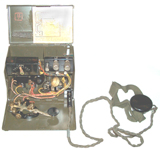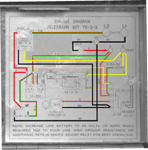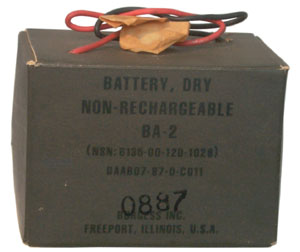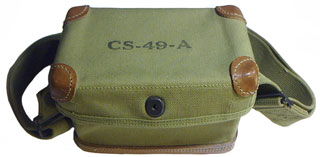TG-5 Telegraph Set
© Brooke Clarke 2004 - 2022

Background
Power
CS-49 Canvas Carry Bag
TM 11-351
Related
Links
Background
The TG-5 came out in the mid 1930s,
more than a decade after the
Fuller Phone.
It
uses
an
interrupter that is essentially an earphone with a carbon contact
type switch driven by the diaphragm. The TG-5 must be
operated with the bottom of the case level for the interrupter to
work properly. It runs at about 1 kHz.
The signal sent over the wire is a DC level, not an audio
tone. There's a sensitive relay that detects this DC current
and when it closes sounds the tone (if the hi impedance headphone
is physically plugged into the jack-switch) or sounds the door
bell if the plug is removed.
The interrupter is a cleaver way to generate a 1 kHz tone without
any tubes or transistors. For more about the BZ-7 see the
ML-138.

This is not a phone, but a
Morse code set that works with a pair of field wire or more
commonly with a single wire (or phantom wire) and an Earth
ground. 4 x 7 x 5" high. Uses 2 ea. BA-30 "local
batteries" and one each (or more if needed) BA-2 22.5 Volt
"line Battery". The 22.5 Volt BA-2 has wire leads to connect
to the binding post. The two BA-30 "D" flashlight cells go
in a compartment on the back of the box. Uses a single
earphone (HS-32) that stows in the top right of the box. The
top left is the larger battery compartment.
These work with a single wire line and a ground return path,
similar to the Fuller phone using a 1,000 Hz tone generated by in
interrupter BZ-7-N.
TM 11-351 Telegraph Sets TG-5 and TG-5-A, Sep 22, 1941.
Change 2, dated 22 July 1943 adds the "B" revision. The "B"
version weight 7 lbs, compared to 6 lbs for the n.c. and "A"
versions caused by the box being made of steel instead of Aluminum
on the n.c. and "A" versions. There are also newer versions
of the interrupter (BZ-7-N) and relay (BK-7-B) in the "B"
version The n.c. and "A" versions have adjustments "spring"
and "gap" while the "B" version has a single "adjust" for relay
optimization.
If you have a CS-49-A canvas case fir a reasonable price please
let
me know.
Power
There are two batteries needed.
Line Battery
A BA-2 dry battery is used for
normal line battery applications, but for long lines additional
batteries can be connected in series. Each BA-2 supplies
22.5 Volts. It may be that the TG-5 application is the
reason these were still being made.

Label
Battery, Dry
Non-Rechargeable
BA-2
(NSN: 6135-00-129-1020)
DAAB07-87-D-C011
0887
Burgess, Inc.
Freeport, Illinois, U.S.A.
3 3/8" wide (3 5/8 counting bulge) x 2 1/2" tall (excluding wires) x
1 15/16" deep. 12.6 oz. DMM shows 22.97 Volts open
circuit.
You could use three each 4 cell AA battery holders in series with a
3 cell AA battery holder (15 cells total or about 22.5 Volts total)
Local Battery
A couple of BA-30 (common "D"
cells) are used for local power.
CS-49-A Canvas Carry Bag
Bag photos from John Forster.
Manual TM 11-351 w/ Changes 1 & 2
I have scanned, cleaned about 95% of
the prior copy curd, added some color photos, extensive bookmarks
and internal links for paragraph and figure references as well as
in the Table of Contents. TM 11-351. The manual was written
for the TG-5 and TG-5-A and the two changes add information for
the TG-5-B, BUT the changes then were not done are complete pages
that could be inserted, but rather as comments, making it very
difficult to actually change the manual. This idea was to
just keep the change pages with the manual and refer to
them. Not a very practical system, and that's probably why
it was changed to the current method of changes. So you need
to read the changes on this manual.
TM 11-351 on CD-ROM to U.S. mailing address $11.50.
You can use your charge card by means of PayPal
or send a cashier's check or money order to:
Brooke Clarke
3425 Deerwood Dr.
Ukiah, CA 95482
USA
Possible Patents
1284480
Vibrator, Herbert
Edward Shreeve. Western
Electric, 1918-11-12, -
1516260 Inclosed-diaphragm buzzer,
F.W. Wood, 1919-08-07 - half of a BZ-7, i.e. missing the
carbon mike. - ML-138
Related
Links
Back to Brooke's PRC68, Products for Sale, Military Information, Telephones, Personal Home
[an error occurred while processing this directive]This is the time this
page has been accessed since since 3 July 2004.

 This is not a phone, but a
Morse code set that works with a pair of field wire or more
commonly with a single wire (or phantom wire) and an Earth
ground. 4 x 7 x 5" high. Uses 2 ea. BA-30 "local
batteries" and one each (or more if needed) BA-2 22.5 Volt
"line Battery". The 22.5 Volt BA-2 has wire leads to connect
to the binding post. The two BA-30 "D" flashlight cells go
in a compartment on the back of the box. Uses a single
earphone (HS-32) that stows in the top right of the box. The
top left is the larger battery compartment.
This is not a phone, but a
Morse code set that works with a pair of field wire or more
commonly with a single wire (or phantom wire) and an Earth
ground. 4 x 7 x 5" high. Uses 2 ea. BA-30 "local
batteries" and one each (or more if needed) BA-2 22.5 Volt
"line Battery". The 22.5 Volt BA-2 has wire leads to connect
to the binding post. The two BA-30 "D" flashlight cells go
in a compartment on the back of the box. Uses a single
earphone (HS-32) that stows in the top right of the box. The
top left is the larger battery compartment.

